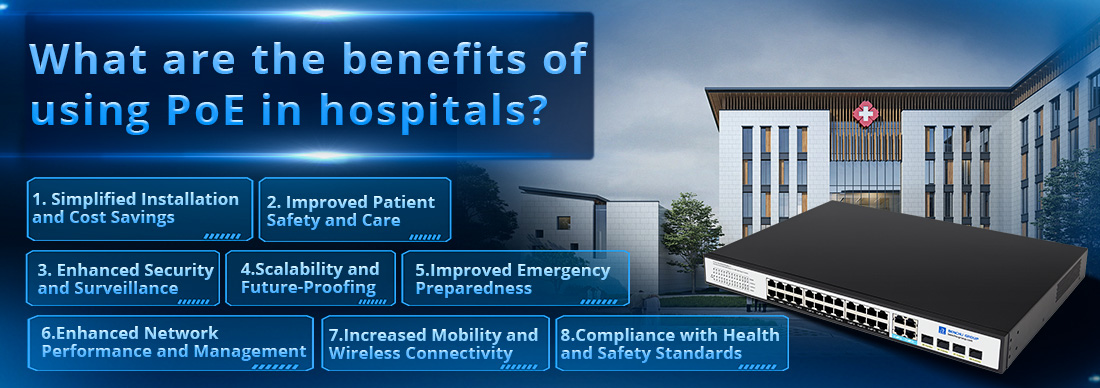
Power over Ethernet (PoE) technology offers significant benefits when used in hospitals, enhancing both operational efficiency and patient care. Here are the key advantages:
1. Simplified Installation and Cost Savings
Reduced Wiring: PoE eliminates the need for separate electrical wiring for powered devices, reducing installation complexity and labor costs.
Flexible Deployment: Devices like IP phones, wireless access points, and cameras can be installed in areas without existing power outlets, making it easier to adapt to changing hospital needs.
2. Improved Patient Safety and Care
Reliable Power for Medical Devices: PoE can provide uninterrupted power to essential devices like nurse call systems, patient monitors, and telemedicine equipment, ensuring they function without disruptions.
Enhanced Communication Systems: PoE powers IP phones and intercoms, allowing for reliable internal communication between hospital staff, improving response times in emergencies.
3. Enhanced Security and Surveillance
Centralized Power for Security Cameras: PoE simplifies the setup of IP-based security cameras throughout the hospital. These cameras can be installed in critical areas to ensure constant monitoring of patients and facilities.
Remote Monitoring and Control: Network administrators can easily monitor and control PoE-powered devices like cameras, access control systems, and door locks from a centralized location, increasing security and efficiency.
4. Scalability and Future-Proofing
Support for IoT and Smart Devices: PoE networks can support the growing number of IoT devices used in hospitals, such as smart lighting, environmental monitoring, and connected medical devices.
Easily Expandable: As hospitals grow or upgrade, additional PoE devices can be installed without the need for significant electrical infrastructure changes.
5. Enhanced Network Performance and Management
Centralized Power Management: PoE switches allow IT teams to monitor and manage power delivery remotely, ensuring that critical devices remain powered and operational.
Energy Efficiency: Hospitals can conserve energy by automatically turning off PoE devices when not in use, helping to manage electricity consumption and reduce operating costs.
6. Increased Mobility and Wireless Connectivity
Seamless Wi-Fi Coverage: PoE can power wireless access points (APs) across the hospital, providing reliable and continuous Wi-Fi connectivity for medical staff, patients, and devices.
Mobile Health Solutions: PoE supports mobile devices and telemedicine solutions, enabling doctors and nurses to access patient data, communicate, and provide remote care from anywhere in the hospital.
7. Improved Emergency Preparedness
Backup Power Integration: In case of a power outage, PoE systems can be connected to backup power supplies, such as UPS systems, to ensure that critical communication and security devices remain operational.
Quick Recovery: PoE systems allow for quicker restoration of network services in the event of power disruptions, critical in maintaining the hospital's operational continuity.
8. Compliance with Health and Safety Standards
Low Voltage and Safety: PoE operates at low voltage, which reduces the risk of electrical hazards, ensuring compliance with strict healthcare regulations regarding electrical safety in patient environments.
In summary, using PoE in hospitals delivers cost efficiency, flexibility, scalability, and reliability, contributing to enhanced patient care, improved security, and streamlined operations.